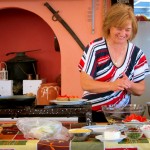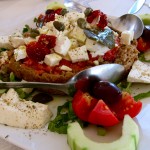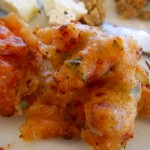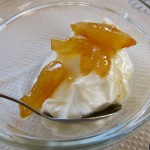I have always wanted to travel to Greece, not predominantly for the cuisine, but let’s be honest; food sells me on visiting just about anywhere. That said, I was pleasantly surprised to see that Greek salads are exactly the cubed tomato, cucumber, onion, olives and feta that I had imagined. Other Greek specialties, however, were not always quite so consistent with my preconceptions. For example, every moussaka I sampled was unique in its own special way. Every island, every family, every nana has a different twist of their own. Additionally the staple ouzo and mezze combo, though it could be found everywhere, always provided an exciting twist. Various mezze staples like the Greek salad, hummus, aubergine and garlic-rich tzatziki were generally present, but similar to the moussaka, other mezze differed drastically from island to island. This distinction was not something I realized until attending a cooking class in Santorini with my mother. In awe of the breathtaking caldera views and lapis colored waters, we stumbled into an unassuming taverna at the south end of the island, where we would take part in a cooking class, enjoy some Greek wine, and dine with the chef, her husband, and their extended Greek family.
Once settled in Taverna Aeolos, Chef Litsa welcomed us all (with the help of a translator) and got down to business at a table full of local ingredients. She explained that they never really had soft bread on the island, and made due with the hard, stale bricks they always had on hand. By wetting them with water and olive oil and drenching each piece in juicy, sun-soaked tomatoes, a sort of pan con tomate was born. This bread was served with Santorini’s version of feta – a seemingly saltier version cut into rectangular cubes. Next up came tomato keftedes – which I would basically call a fried salad patty. Litsa mixed spearmint, basil, tomato and whatever veggies were on hand with water in a bowl, and added a handful of flour to keep it together before frying spoonfuls into golden disks. Of the few things that grow on the island, fava beans are a coveted food source and were historically milled on dry stone circles. Litsa demonstrated a use of this commodity by making a fava bean paste, similar to hummus. The game changer was when she added the most phenomenal capers and local olive oil on top to create a savory and refreshing spread that we couldn’t help but add to everything. After sampling a beautiful lamb dish, we finished off the meal with fresh Greek yogurt and candied orange peel that could have kept me savoring at that table for all of eternity. By the end we were full, happy, and to be honest, a bit drunk! But as Chef Litsa and her husband explained, strong healthy Santorinians like to drink, and that’s why they have so many children to feed!



